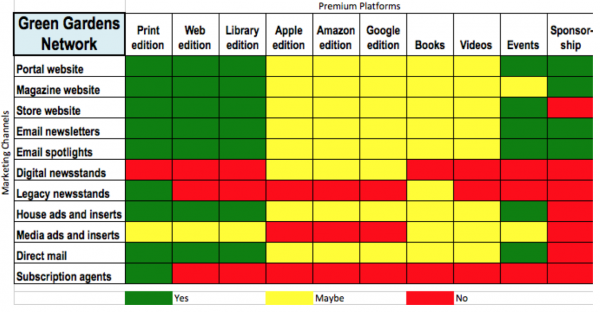How to build a website with an eye on architecture and multiplatform publishing
If you give a mouse a cookie, then it’s going to want some milk. If you own a magazine, then you’re going to want to build a website. If you do not yet have a website, or rather, if you do not yet have a good, profitable website, then your next steps are as follows.
And yes, if there was ever a true use for the phrase over-simplification, you’re about to read it.
Let’s also think hypothetically, and that we hypothetically own an organic gardening magazine.
Ten questions that will help you determine how to build a website for your magazine
1. What is my niche?
Understanding where you land, and who your competitors are, is the first step on your path to building a website for your magazine. If you are an organic gardening magazine, you’re in the gardening niche. And since gardening isn’t actually niche enough, you’re more specifically in the organic gardening niche.
2. How do I make money?
If you’re advertising-based like most consumer magazines, your design will revolve around the most desirable ad space on your website. If not, it will revolve around featured product advertising slots. There are also other subscription website business models you can add you your website, like an application or a reference site for further revenue.
2. Who is my audience?
Who’s most likely to buy my magazine? This will not only help you determine your website labeling and taxonomy, but it will also help determine what kinds of products you should develop. It is a Mequoda best practice to build a portal for every subscription website you create. Portals are intended to build and feed an audience; they are specially designed for SEO, email marketing, list building, and lead generation. You should know everything about your audience before building a portal.
3. What are my most popular topics?
If you’re an existing magazine, look at the articles that have received the best feedback and acclaim from your readers. Use this data to form a big picture of where your website should focus its efforts.
4. What is my audience looking for, in regards to my most popular topics?
Keyword research should dictate, or at least play heavily into, your overall taxonomy and editorial strategy. You may begin thinking that you want to write about topics like “organic recipes” “organic vegetables” and “organic fruits” but then determine that you’ll get more traffic by writing about “organic vegetable gardening,” “organic gardening supplies,” and “organic container gardening.”
5. What channels will my website include?
Using that keyword research, finalize a list of ten channels. These are broad topic categories using keywords you’ve researched, like the “organic vegetable gardening,” “organic gardening supplies,” and “organic container gardening.” These will be the primary topics you’ll write about and how your articles will be organized. Learn more about 3C zone architecture.
[text_ad]
6. What product can I create for each channel?
For every channel, you’ll create a related product that can be promoted in that zone. For example, an article called “10 Greatest Organic Gardening Supplies” can be published in your “Organic Gardening Supplies” zone while promoting an eBook called Everything You’ve Ever Wanted to Know About Buying Organic Gardening Supplies.
7. How do I plan to sell my magazine?
Will you be selling a digital magazine or an online magazine? Will you be selling products through a cart store, or a solo order flow? A cart-based store like Amazon offers many products for sale and uses a shopping cart for checkout. An event-based store like Farm Progress Show sells one or many events, but may also have many different price / package tiers or number of attendees. A solo-based store like Independent Living Bullion uses a solo order flow instead of a cart system.
8. What products do I intend to create?
Since building a website opens the doors to more digital products, we can imagine what else could be offered on the new website. Below is our Mequoda Multiplatform Media Matrix.
Across the top, you’ll see various kinds of premium platforms for creating products. Also, these are streams of revenue. There can be others too, depending on your business. For example, data could be a platform if you have a directory.
Down the left side are the different marketing channels, showing us where those platforms or products can be promoted.

The Mequoda Multiplatform Media Matrix is all one big way of figuring out where your opportunities exist. The way to read the Matrix is by taking one column and reading it downward. We coded it green, yellow and red—like a traffic light—to identify which ones we see as easy, and which ones are more difficult to expand.
9. How do I intend to promote my products?
Will your products be hosted on your site? And in what ways will you promote them? Will there be email newsletters? Ads? Text ads? OFIEs? How will you send traffic back to your site, or present your products to the world?
10. Who should build my website?
That’s easy. If you’re a niche magazine publisher, there’s no consultancy and web development duo better equipped than us. 🙂 Schedule a call with us to get started.



Learning to build your own website is such an underrated skill these days. If you want to be more indispensable in any work place or give a launch pad to any entrepreneurial ideas, having the knowledge and skills to create a quality site is invaluable.
Best of luck!
AL